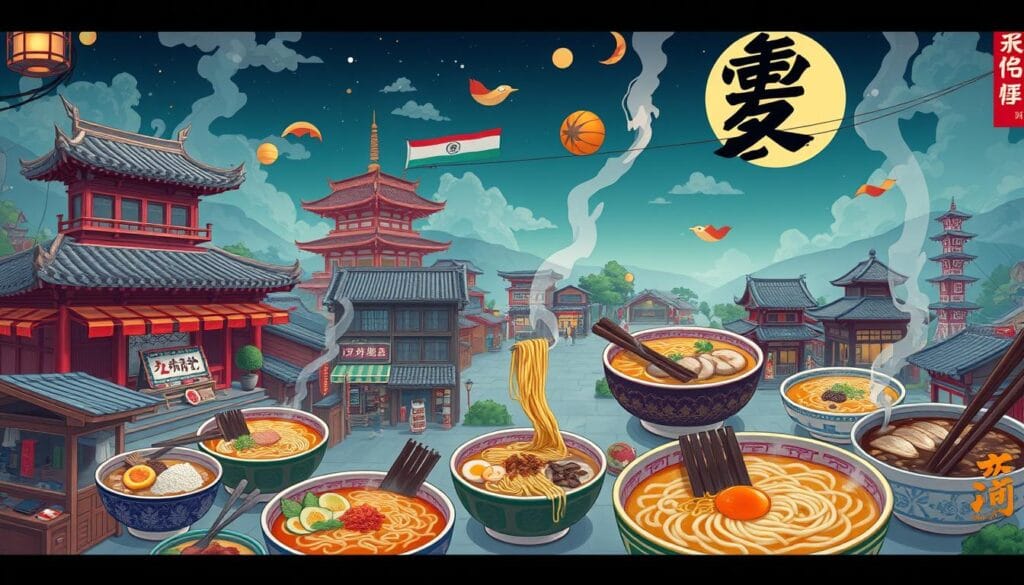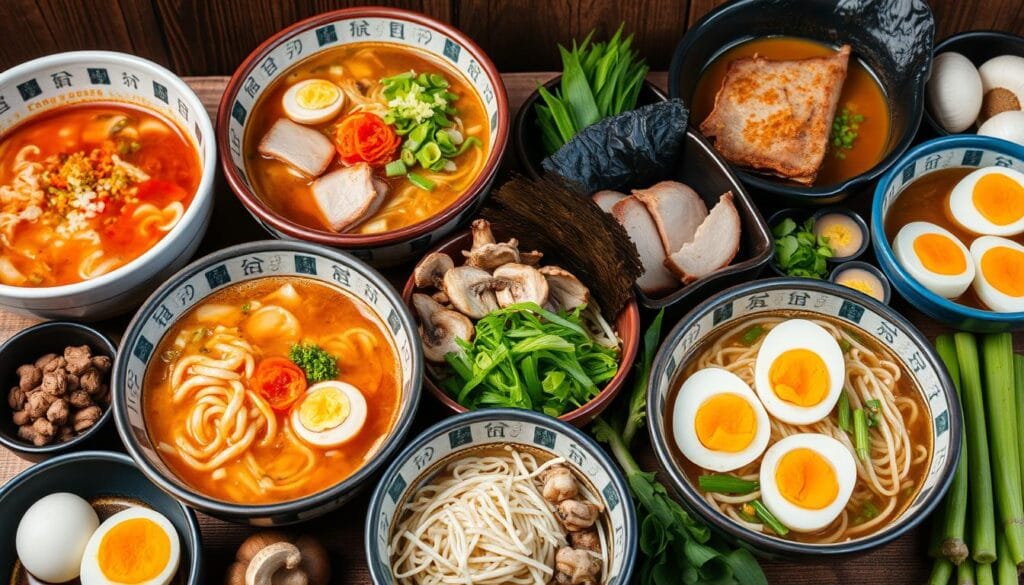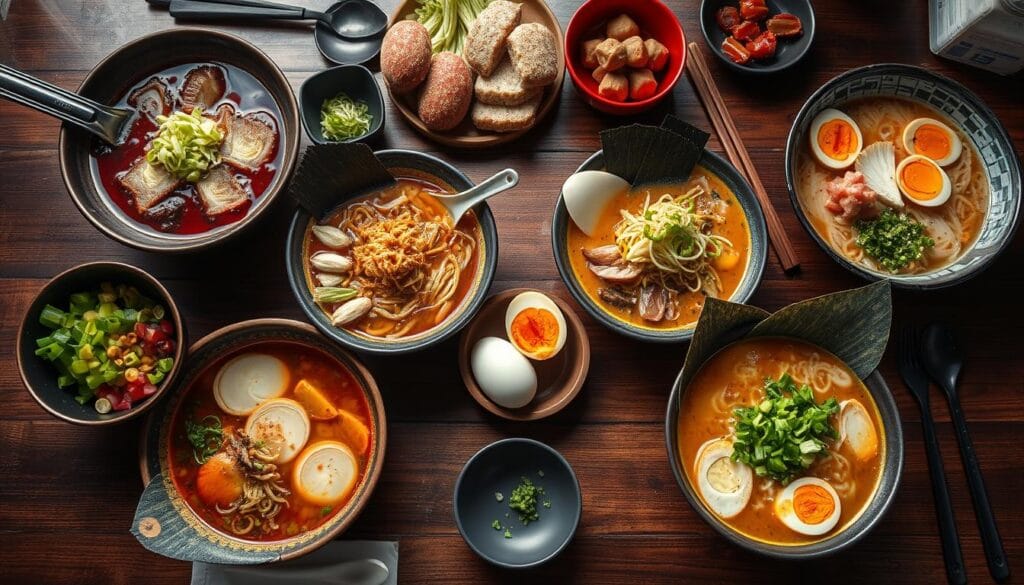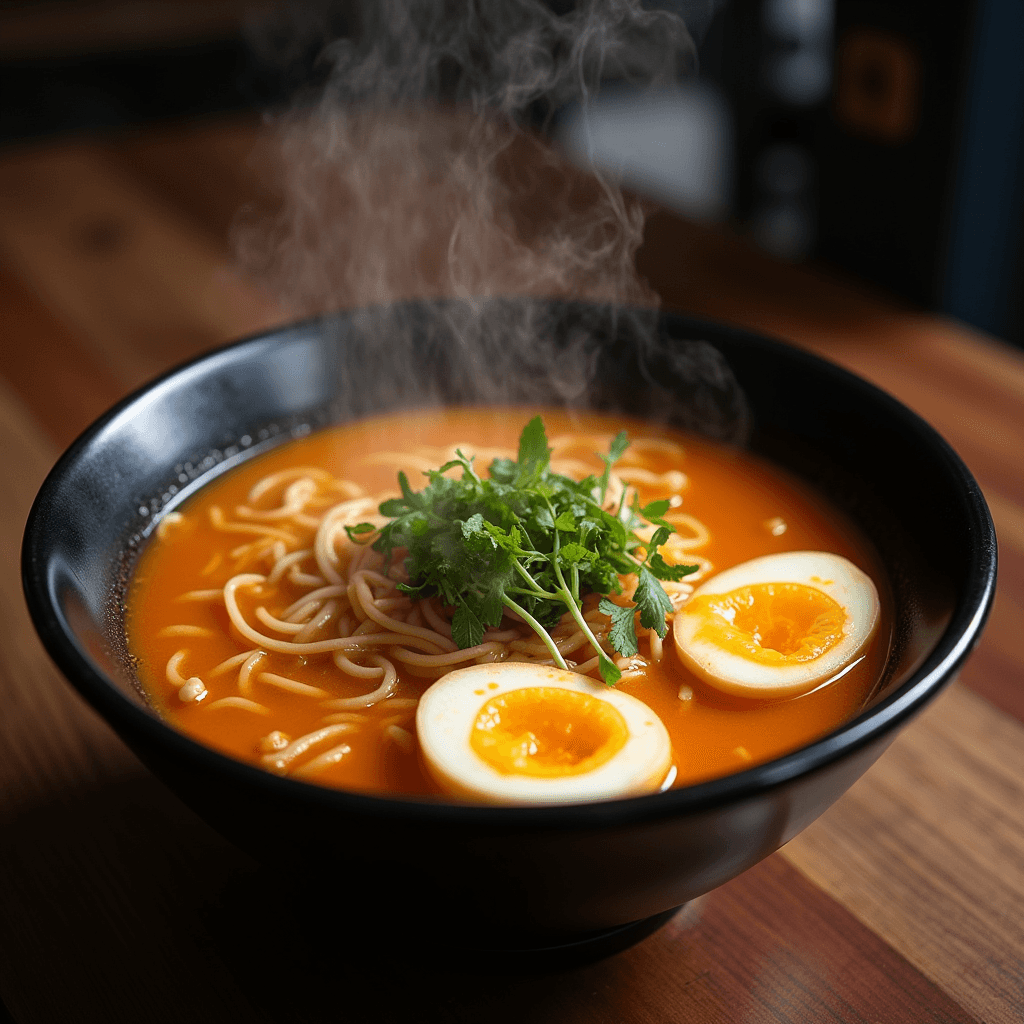Creamy Ramen Soup: A Japanese tradition
Ever wondered why Ramen Soup, the famous Japanese noodle soup, is so loved? It’s not just the hot broth, chewy noodles, and toppings. Its charm comes from its deep history, many regional styles, and the skill in making it. This guide will show you the secrets of this beloved dish and why it’s loved worldwide.
What makes it special? Is it the mix of flavors, the texture, or the warmth it brings? Exploring it, you’ll see its rich history, culture, and cooking art. These elements have made it a legendary dish.
Table of Contents
- Essential Components of Traditional Ramen soup
- Regional-R Styles Across Japan
- Sapporo Miso Ramen soup
- Hakata Tonkotsu Ramen soup
- Tokyo Shoyu Ramen soup
- Regional-R Styles Across Japan
- From Street Food to Gourmet: Modern Ramen soup Culture
- Ramen soup Shop Culture
- From Street Food to Gourmet: Modern Ramen soup Culture
The History and Origins of Japanese Ramen soup
This beloved Japanese noodle soup has a rich history. It started in the late 19th century with Chinese immigrants. They brought their noodle-making skills to Japan, calling it “Shina soba” or “Chuka soba.”
The term “Ramen” was first used in 1928. After World War II, its popularity soared. It became a cheap, filling meal for many. Now, we have Shoyu , Miso, Tonkotsu, and Shio among others.
Evolution in Japanese Culture
It’s journey in Japan shows the country’s love for food. The first R-shop, Rai Raiken, opened in 1910 in Tokyo. The 1923 earthquake helped it stalls spread, making it more popular.
Modern-R Revolution
The modern Ramen soup scene is all about creativity. In 1958, Momofuku Ando introduced instant Ramen soup. The Shinyokohama Ramen Museum, opened in 1994, lets people try different Ramen soup types.
Now, it is loved all over the world. In the U.S., Its bars and creative dishes are everywhere. This shows ramen’s lasting appeal.

“Slurping ramen is encouraged in Japan as it helps cool the noodles and enhances the flavor.”
Essential Components of Traditional-R
Ramen soup is a beloved Japanese noodle soup. It’s made from carefully chosen ingredients. These include its ingredients, broth, noodles, flavoring sauce (tare), and toppings.
The noodles are key to this dish. They’re made from wheat flour, salt, water, and kansui that gives them a special texture and bite. These noodles have more protein than other noodles, with 10-13%.
The broth is the heart of this dish. It can be chicken, pork, or vegetable based. There are two main broths: Paitan, creamy and thick, and Chintan, clear and delicate. Each has its own flavor.
The toppings make a traditional ramen bowl complete. Toppings include chashu (braised pork), Nita Mago (marinated soft-boiled eggs), nori (seaweed), and fresh vegetables. They add to the dish’s look, texture, and taste.
Understanding it’s essential components shows the skill in making this Japanese dish. It’s a true culinary masterpiece.

“Ramen is the ultimate comfort food, a perfect balance of nourishing broth, springy noodles, and flavorful toppings that never fails to delight the senses.”
Understanding Ramen Soup Broths and Their Varieties
Ramen soup broth is the heart of this Japanese dish. It comes in different types, each with its own taste and texture. The main types are Paitan and Chintan, known for their looks and how they’re made.
Paitan (Creamy White Broth)
Paitan broths are thick and creamy, with a milky-white color. They’re made by boiling bones, like pork or chicken, for a long time. This makes the broth rich and velvety.
Chintan (Clear Broth)
Chintan broths are light and clear, with a subtle taste. They’re made by simmering ingredients and then removing any impurities. This creates a clean broth that highlights the flavors of the ingredients.
Specialty Regional Broths
Ramen soup also has many specialty broths from different regions. For example, Sapporo’s Miso has a deep umami flavor. Hakata’s tonkotsu it is famous for its creamy pork broth. These broths show the diversity and richness of this dish, thanks to local ingredients and methods.

R-Noodle Types and Textures
The heart of any delectable ramen dish lies in the noodles, known as Chukamen. These noodles are made from wheat flour, salt, water, and kansui (an alkaline mineral water). This gives them a yellow hue and a chewy texture. Ramen soup-noodles have a higher protein content, ranging from 10-13%, which makes them unique.
The thickness and shape of R-noodles vary. Some are thin and straight, while others are thicker and wavy. By adjusting the water-to-dough ratio, different textures can be created. This allows for a wide range of options to match different broths and personal tastes.
- Wavy R-noodles are often paired with rich broths like Shoyu and Shio. The nooks and crannies help the soup cling to the noodles.
- Straight ramen-noodles, with their smooth texture, are commonly used in Tonkotsu. They cook quickly.
- Thick, dense, and chewy ramen-noodles are well-suited for heartier broths like Tonkotsu. They can soak up the creamy broth while retaining a satisfying bite.
The cooking time for ramen-noodles varies. Thin noodles take about 2 minutes, while thicker ones need around 4 minutes to achieve the perfect al dente texture. Rinsing the cooked noodles under running water can help reduce salt content. This is especially useful for instant ramen, where seasoning packets can add extra sodium.
The Art of Tare: Flavoring Sauces
Shoyu (Soy Sauce Base)
Shoyu tare is a savory sauce made with soy sauce. It’s mixed with garlic, ginger, and sometimes dashi for a complex flavor. This tare works well with many ramen-broths.
Miso (Fermented Soybean Base)
Miso tare uses fermented soybean paste for its rich flavors. It adds depth and heartiness to the broth. The flavor can be light or bold, depending on the miso type. It’s a favorite for Miso.
Shio (Salt Base)
Shio tare is a simple, yet flavorful sauce based on salt. It’s seasoned with garlic, ginger, and sometimes bonito flakes. This tare offers a clean, light taste that highlights the broth’s flavors.
Each tare type brings a special touch to ramen. Chefs and home cooks can adjust the flavors to their taste. Learning to make tare is crucial for a great bowl of this magnific soup.
“The key to a great bowl of ramen lies in the perfect balance of the broth, noodles, and tare. Each component must work in harmony to create a truly memorable dining experience.”
Classic Ramen soup Toppings and Garnishes
It is more than just noodles and broth. The toppings and garnishes make it special. Chashu (braised pork belly) and Nitamago (marinated soft-boiled eggs) add flavor and beauty to the bowl.
Chashu is tender and flavorful, melting in your mouth. Nitamago has a runny yolk that pairs well with the broth. Nori (seaweed sheets) and green onions (negi) add savory and crunchy elements.
Regional-ramen has its own twists. Sapporo might include butter, while Hakata has spicy pickled ginger. Menma (fermented bamboo shoots) adds a unique texture and flavor.
Whether you like it classic or adventurous, toppings are key. Try different combinations to find your favorite. This will take your dish to the next level.
| Ramen Type | Common Toppings |
|---|---|
| Shoyu (Soy Sauce) | Chashu, Nitamago, Nori, Negi, Menma |
| Tonkotsu | Chashu, Nitamago, Nori, Negi, Menma |
| Miso | Chashu, Nitamago, Nori, Negi, Corn |
| Shio (Salt) | Chashu, Nitamago, Nori, Negi, Menma |
| Spicy | Chashu, Nitamago, Nori, Negi, Kimchi |
| Tsukemen (Dipping ) | Chashu, Nitamago, Nori, Negi, Menma |
| Vegetarian | Tofu, Mushrooms, Spinach, Corn, Menma |
It is all about personal taste. Feel free to try new toppings and garnishes. This way, you can make your own unique R-dish.
Regional Ramen soup Styles Across Japan
Japan’s dish scene is a mix of many regional styles. Each has its own special flavors and traditions. From the creamy Sapporo miso to the rich Hakata tonkotsu, and the classic Tokyo shoyu , these variations show the depth of this Japanese dish.
Sapporo Miso-R
This dish comes from Sapporo in the north. It’s known for its thick, miso-based broth. It also has sweet corn and butter, making the soup rich and full of umami.
Hakata Tonkotsu-R
From Fukuoka’s Hakata district, hakata tonkotsu-Ramen is famous. It has a creamy pork bone broth and thin noodles. The long cooking time brings out the pork’s full flavor, making it a treat.
Tokyo Shoyu-R
Tokyo is where modern-Ramen started. The Tokyo Shoyu-ramen is a classic. It has a clear soy sauce broth and curly noodles. This style lets the flavors balance, making it a favorite among ramen fans.
“Ramen has evolved from sustenance food to a culinary phenomenon in Japan, with each region proudly showcasing its unique interpretations of this beloved dish.”
Making Ramen at Home: Essential Techniques
Making homemade-R can seem hard, but it’s easier than you think. You just need to know a few key steps. These include making the broth, choosing the right noodles, and adding tasty toppings.
Mastering the Broth
The broth is the heart of ramen. Start by making a dashi, a Japanese stock from kombu and bonito flakes. Add garlic, ginger, and shiitake mushrooms to the dashi for a deep, umami flavor.
Perfecting the Noodles
While fresh noodles are ideal, you can also use instant ramen for a good taste. If you want to try making noodles from scratch, use a simple recipe and a pasta maker for the right texture.
Crafting the Toppings
- Slow-braised chashu (pork belly) is a classic-R topping. Marinate and cook the pork until it’s tender and flavorful.
- Prepare nitamago, or soft-boiled eggs, by cooking large eggs for 6 minutes, then marinating them in a mixture of soy sauce, sugar, and mirin.
- Don’t forget to include fresh, crunchy toppings like scallions, shredded carrots, and crispy panko crumbs to add texture and flavor to your homemade-Ramen.
With patience and the right techniques, you can make amazing ramen at home. Try different broths, noodles, and toppings to find your favorite. Impress your friends with your ramen-making skills.
The Role of Aromatics and Seasonings
Ramen is more than noodles and broth. Aromatics and seasonings are key to its flavor. Garlic, ginger, and spring onions form the base, adding a fragrant touch.
Other seasonings like white pepper, sesame oil, and togarashi add depth. Chili oil brings heat, while soy sauce or miso paste add umami.
| Ramen Seasoning | Flavor Profile | Common Uses |
|---|---|---|
| Garlic | Pungent, savory | Aromatics, tare sauces |
| Ginger | Warm, slightly spicy | Aromatics, broth, tare sauces |
| Spring onions | Mild onion flavor, slightly sweet | Garnish, aromatics |
| White pepper | Subtle heat, earthy | Broth, tare sauces |
| Sesame oil | Nutty, aromatic | Tare sauces, finishing touches |
| Togarashi | Blend of spices, citrusy | Garnish, tare sauces |
| Chili oil | Fiery, complex | Broth, tare sauces, finishing touches |
| Soy sauce | Savory, umami | Tare sauces, finishing touches |
| Miso paste | Umami, slightly sweet | Broth, tare sauces |
By mixing these ramen-seasonings and aromatics right, you can make a flavorful dish. Whether you like it spicy or subtle, the right mix can turn noodles into a masterpiece.
From Street Food to Gourmet: Modern Ramen-Culture
Ramen has come a long way, from a simple street food to a gourmet dish loved around the world. In Japan, ramen-shops are everywhere, serving quick meals to keep up with the demand. Today, ramen has seen a big change, with new ideas that have taken it to new heights.
Ramen-Shop Culture
In Japan, ramen-shops have their own special culture. They serve busy city people with a simple menu, focusing on their signature-ramen. Customers quickly enjoy their meals, making room for others, creating a fast and lively atmosphere.
Contemporary Innovations
The R-culture has seen a lot of new ideas, pushing the limits of traditional ramen-soup. Now, you can find it with flavors from around the world, like yuzu, wagyu beef, and even sea urchin. There are also vegetarian and vegan options, showing how versatile ramen can be.
Global Influence
Gourmet-R has become popular worldwide, leading to its inclusion in fancy restaurants and fusion dishes. This global love for this recipe has brought new twists to the classic dish. It has also made people appreciate the art of R -innovations and the wide range of flavors it offers.
FAQ
What is ramen?
It is a beloved Japanese dish. It’s made with wheat noodles and served in a tasty broth. You can add many toppings to it. It’s a big part of Japanese food culture.
How did Ramen soup originate?
It started in China and came to Japan in the early 1900s. At first, it was called “shina soba” or “chuka soba.” The name “ramen” came in 1928.
What are the main components of traditional-R?
Traditional ramen has five key parts. These are noodles, broth, fats and oils, flavoring sauce (tare), and toppings.
What are some common ramen-toppings?
Common toppings include chashu (braised pork belly), nitamago (marinated soft-boiled eggs), and menma (fermented bamboo shoots). Nori, green onions, and corn are also popular.
How can I make ramen at home?
Making it at home needs several steps. First, make the broth. Then, cook the noodles and prepare toppings. Key steps include making dashi, braising chashu, and marinating eggs for nitamago.

